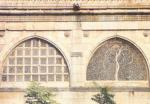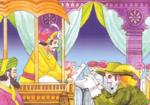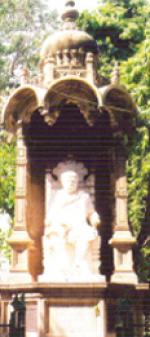After Delhi Sultanate ended the Mughal rule replaced it. The Mughals sent governors or 'Subas' to rule over provinces. At this time the most powerful Sidi noble Juhar Khan's intimate friend Sidi Sayyed constructed a Masjid and the stone lace carvings here have become famous for its delicate art. There are 3 major such carvings on its wall. Through a thick stone carvings are so cleverly made as to look like a laced net. Panels of the stones are joined to give a continuous effect. One such panel has the designs of tree and its branches with leaves and another has geographical patterns. The middle panel, it is said, has been taken out of the country. Some historians believe that while this construction was going on, the armies of Mughals invaded and so it remained incomplete. However, even today thousands of people come here to take a look and admire the extraordinary skill that made the lace in st~ne possible. They carry back its replicas in wood or silver as a memento. The replicas of this Sidi Sayyed ni Jali are also placed in museums abroad.
Ahmectabad acquired new significance during Mughal rule. The sons of the Emperors themselves came here as Subas of Gujarat. Jahangir roamed Ahmedabad a great deal boh as crown prince and as emperor. After his meeting ith Sir Thomas Roe, he wrote the letters to King James from here. Their historical meeting was held at Naginawadi of Kanakria lake in 1618 AD and at the time neither of them had any idea as to how significant that meeting was for India as well as England. This was the time of sowing the seeds of British domination over India. No one could ever visualize that the permission to trade, given so lovingly would lead one day to tie the huge country into chains of near-slavery at a later date. The seeds of that enormous time were sown on the soil of Ahmedabad and its effects were to be felt for the next two centuries, and even more
Ahmedabad was highly respected in Mughal court. Shantidas Zaveri was the Imperial Zaveri while the Jain ascetics of Ahmedabad were advisors to Akbar. Jahanagir had a great love for paintings. Almost at the end of the Mughal rule Persian was replaced by Urdu as the court language. At that time Vali Gujarati of Ahmedabad was the leading Urdu poet. His Dargah can be seen at the Shahibaug Underbridge
In 1818 AD the English flew the Union Jack over Ahmedabad. In an earthquake of 1819 two minarettes of Jama Masjid toppled down. In 1832, Mr. Vibert hunted a tiger in the mosque of Rani Rupmati. (Thi~ indicates the situation of the city then.) The English began the works that now Municipality and Municipal Corporation does. In 1846 the practice of sprinkling water· on roads and putting up streetlights began. In 1849 repairs for the Bhadra fort began. After a number of years of chaos, now people of Ahmedabad could see some order returning to their city, and they could breathe a sigh of relief. That is why Dalpatram's poem was composed praising the English administration: 'E Upkar Gani Ishvar no, harakh have tun Hindustan
During the1857 uprising we do not find much anti-English activity here. In 1859 Ranchhodlal Chhotalal began the first textile mill in Ahmedabad. In 1864 a station of B.B.& c.l. Railway was constructed at Kalupur. In 1855 elections were held to choose people's representatives in Municipality and the Father of Cotton mill industry, Ranchhodlal Chhota1al became its first President. In spite of opposition form different quarters and conservatism of the public, Ranchhodlal introduced pipes to carry water to each home and also laid gutter lines in the city. His grandson Chinubhai Madhavlal (Baronet) was a great philanthropist and served the city in many different ways.
The Hatheesing Jinalaya or Jain temple at Shahibaug is a most wonderful structure in Ahmedabad for grandeur and beauty. Premchand Salat, the architect, created this temple in 1850. from pure white marble stone. A beautiful Mandap with one story greets you at the entrance. It is called Meghnad Mandap. At the center of the open space within is the main temple while 53 smaller Jinalyas surround it. The front hall, Middle hall and the gabhara or garbhagriha are constructed with excellent architectural sense. There is one story above while an underground cellar is also found below the surface. The small settlement that Seth Hatheesing created here besides gardens and Dharamshalas was known as 'Hathiparu' earlier
Seth Hatheesing Kesarisingh was a noted wealthy merchant and his wife Harkunvar Sethani also was a religious minded lady, a philanthropist and social reformer. Way back in 1850 AD when the general public was still not in favor of female education, she built the first institution for women, Maganlal Karamchand Girl's School in Ahmedabad.
Harkunvar also built Dharmanath Derasar in Nisha Pol, and several other such Jain temples like Sambhavnath, Chintamani Parshvanath)emples at Zaveriwad, and Adishvamath temples also ~ame up in this period.
Among the non-lain temples the ancient ones are difficult to find. Yet, Kamnath Mahadev at Raipur Darwaza, Bhimnath Mahadev at Shahaibaug, temples of Bhadrakali, Bahucharaji and Ambaji at Bhadra, Vaishnav Haveli at Doshiwada ni Pol and many other temples dedicated to Ranchhodji, Shri Krishna and Ram are to be seen here. Many recent temples with modern architectural style are also now seen, though most of lain temples are still built in the old classical style.
A large number of institutions flourished in Ahmedabad - Gujarat College, for instance - and development continued. The industries also clustered here. The cotton mill industry flourished so well that the city came to be called Manchester of India. Gandhiji arrived ... Ahmedabad played unique role in freedom struggle .. .Independence came ... Gujarat separated as a full State of the Indian Union ... thus bringing us to the threshold of the present
From all this stems the unique character of the city. Its citizens are of a unique temperament. People of this city do not understand the term 'obedience'; for they make their own rules of life. They are freedom oriented all this while and even in modern times many of defying activities and protests have star1ed from here. The revolutionary's blood seems to flow in its veins. To accept a challenge is its nature, to protest is its specialty. They can enjoy life without worry and as easily can turn into revolutionaries without waiting for motivation from any leader. When the people move like this, they do not worry about their targets -young or old - and even women take part in such activities; they all boldly show their protests even by pelting the police with stones if needed. And this very people of Ahmedabad as easily fold their legs to sit down and listen to the lectures of the revered religious leaders in large numbers.
A unique combination of conservatism as well as the spirit of pre-history down to modern times is found not just in the architecture of this city but also in its people. This is the only city where a wealthy candidate would lose to a poor Fakir in elections. Here the young boys and girls keep fast during Navratri and play 'garbas' and 'ras' in open or even in discotheques. Here the people are miserly in spending money, but donate in large amounts. Here some women observe 'parda' but are capable of not allowing the police to enter their 'Pol' area. Here we see the latest cars moving along with camel cart on its roads. In this city a notice even in later decades of 20th century reads - 'No entry for Elephants' - on a bridge
Now, in time, places have changed in significance and attraction. Yet Ahmedabad retains its love of architecture. We can see many excellent examples of Jain temples built recently. They are built in the same traditional way as the medieval period, which reminds us of our glorious past in the modern times also. On some of the buildings we can make out the influence or even the touch of the world's most revered architect, Le Corbusier himself. The Ahmedabad Mill Owners' Association, ATIRA, NID, Calicao Museum, IIM, Tagore Hall and other places have remarkable modern architectural presence in the city. Even the smaII buildings and residences indicate the influence of modernity. Suren Kar who constructed 'Uttarayan' for Ravindranath Tagore and built 'Retreat' differently artistic and restful home of Seth Ambalal Sarabhai in Shahibaug.
The public spirit of Ahmedabad is very alive. A large number of various institutions flourish due to the philanthropy of its wealthy merchants and due to the cooperation of experts in different subjects and the public support we find that exceIIent institutions have been established and are flourishing here and are working for different fields of culture, science and research, education, religion, public services and others. Ahmedabad is throbbing with colourful past and progressive present
GUJARAT VIDYAPITH
As a part of his freedom struggle, Mahatma Gandhi established Gujarat Vidyapith. In contrast with the English educational system and syllabus, in order to nurture and train youth in patriotic sentiments the new educational system and syllabi were designed here. Gandhiji became its permanent Chancellor. Its building was completed in 1925. Kakasaheb Kalelkar, Acharya Kfipalani, Kishorlal Mahruwala, Dharmanand Kausambi, Muni Jinvijayaji,.Pandit Sukhlal and many other distinguished scholars served at Vidyapith. After Independence it is considered as equivalent to a University.
"Sardar PatelNational Memorial"
The building in which the Sardar Pate INational Memorial is housed is known as Moti Mahal. The legend is that this building was erected to welcome on a grand scale the visiting Emperor Shah Jahan. When however, the dignitary was about to enter the palace sitting on an elephant, his head struck the arch of the entry gate! Evidently it was lower than the emperor sitting on the elephant. Considering this as inauspicious, he turned away. Thereafter he never entered this palace. One legend also commemorates the love between Shah Jahan and Mumtaz. Emperor Jehangir and his Chief Queen Noor Jehan had come visiting Ahmedabad where they lived for 9 long months. Among the persons with them was Mumtaz, the niece of Noor Jehan with whom as a prince the next emperor had fallen in love. Shah Jehan and Mumtaz also spent best years of their youth and loving company in Shahibaug area.
In his, 18th year, Ravindranath Tagore spent nearly six months in this palace. The room in which he studied, wrote and slept is preserved as Tagore Memorial Room. In 1960 the State of Gujarat came into existence. This building was then made into 'Raj Bhavan' or the Governor House. In 1875 when the birth centenary of Sardar Vallabhbhai came up, this building was turned into National Memorial for him









